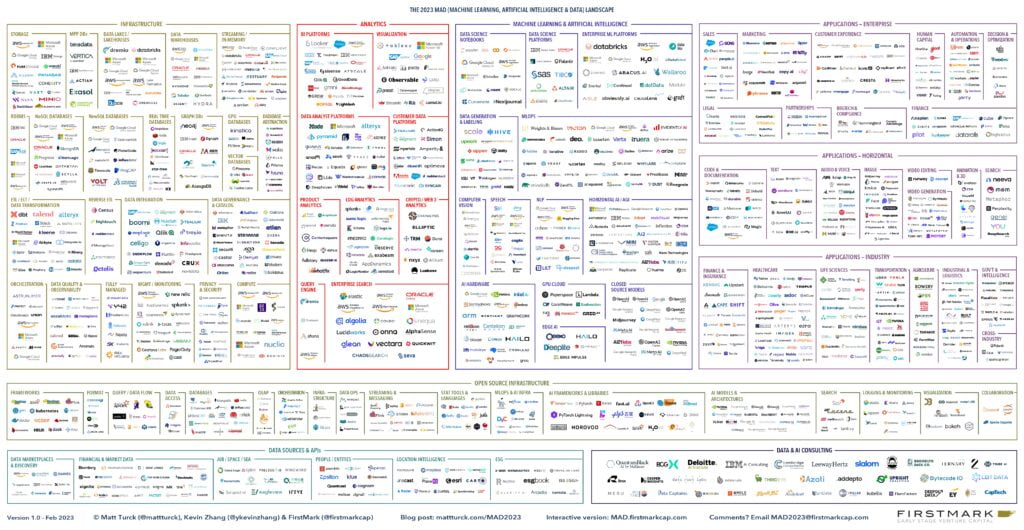Artificial intelligence (AI) and machine learning (ML) are revolutionizing the way businesses operate. From automating routine tasks to improving decision-making, AI/ML technologies are transforming industries and creating new opportunities for growth. To stay ahead in AI/ML trends for business, it’s important to understand the current landscape, develop the necessary skills, and keep up with the latest developments.
AI/ML is already having a significant impact on businesses across a range of industries, from healthcare and finance to retail and manufacturing. According to a survey by PwC, 72% of business decision-makers believe that AI will be the business advantage of the future. Furthermore, the global AI market is projected to reach $267 billion by 2027, with a compound annual growth rate of 33.2% between 2020 and 2027, according to a report by Grand View Research.
However, the adoption of AI/ML technologies in business is not without its challenges. These include data quality, privacy concerns, talent shortages, and ethical considerations. To overcome these challenges and stay ahead in AI/ML trends for business, organizations need to develop a strategic approach to AI/ML implementation.
Current AI/ML Landscape
The rise of data, AI/ML has been one of the most fundamental trends in our generation. Its importance goes well beyond the purely technical, with a deep impact on society, politics, geopolitics, and ethics. Yet it is a complicated, technical, rapidly evolving world that can be confusing even for practitioners in the space.
We continue to believe that there is an essential symbiotic relationship between data and machine learning areas. Data feeds ML/AI models. The distinction between a data engineer and a machine learning engineer is often pretty fluid. Enterprises need to have a solid data infrastructure in place in order before properly leveraging ML/AI.
The release of Open’s AI conversational bot, ChatGPT, on November 30, 2022, marked a significant moment in the mainstreaming of AI. ChatGPT, which has the ability to mimic human conversation, quickly became one of the fastest-growing products ever. Its release based on GPT 3.5 signifies that AI has become a significant aspect of collective consciousness.

See the full MAD (Machine Learning, Artificial Intelligence, and Data) landscape data report in this link
Developing the Skills for AI/ML in Business
Artificial intelligence (AI) and machine learning (ML) are becoming increasingly important for businesses, with AI/ML technologies driving innovation, growth, and efficiency. To stay ahead in AI/ML trends for business, it’s important to develop the necessary skills to work with these technologies effectively.
Best Practices for Developing AI/ML Skills in Business
The following are some best practices for developing AI/ML skills in business:
- Identify the skills gaps in your organization: Identify the skills gaps in your organization and develop a training plan to address them.
- Provide formal training and education: Provide formal training and education to employees, such as online courses, workshops, and conferences.
- Encourage hands-on experience: Encourage employees to gain hands-on experience with AI/ML technologies, such as through hackathons, competitions, and real-world projects.
- Foster a culture of continuous learning: Foster a culture of continuous learning by providing opportunities for ongoing education and professional development.
Best Practices for Implementing AI/ML in Business
Implementing artificial intelligence (AI) and machine learning (ML) technologies in a business setting can be a complex process. However, with the right approach and best practices, businesses can leverage these technologies to drive innovation, growth, and efficiency. In this section, we will discuss some best practices for implementing AI/ML in business.
Define Clear Goals and Objectives
Before implementing AI/ML technologies, it’s important to define clear goals and objectives. This means understanding what problems you are trying to solve, what outcomes you want to achieve, and how AI/ML can help you achieve those outcomes. By defining clear goals and objectives, you can ensure that you are focusing your efforts and resources in the right areas.
Start Small and Iterate
AI/ML technologies can be complex and require significant resources to implement. It’s important to start small and iterate, rather than trying to tackle a large project all at once. This means identifying a small, manageable project that can demonstrate the value of AI/ML and iterating on that project to refine and improve the technology.
Build Cross-Functional Teams
Implementing AI/ML technologies requires collaboration across multiple functions and departments, including data science, engineering, and business leadership. Building cross-functional teams that bring together expertise from these different areas can help ensure that everyone is aligned on goals and objectives, and can help drive innovation and creativity.
Invest in Data Quality and Management
AI/ML technologies rely on high-quality data to deliver accurate and reliable results. Investing in data quality and management, including data cleaning, normalization, and storage, can help ensure that your AI/ML models are built on a strong foundation.
Choose the Right Tools and Technologies
There are numerous AI/ML tools and technologies available, each with its own strengths and weaknesses. It’s important to choose the right tools and technologies for your specific needs, based on factors such as ease of use, scalability, and compatibility with your existing technology stack.
Monitor and Evaluate Performance
Once you have implemented AI/ML technologies, it’s important to monitor and evaluate their performance over time. This means tracking key metrics such as accuracy, efficiency, and user satisfaction, and making adjustments as needed to ensure that your AI/ML technologies are delivering the desired outcomes.
Foster a Culture of Experimentation and Innovation
Finally, implementing AI/ML technologies requires a culture of experimentation and innovation. This means encouraging employees to think creatively and try new approaches, and providing them with the tools and resources they need to do so.
Implementing AI/ML technologies in a business setting can be a complex process, but with the right approach and best practices, businesses can leverage these technologies to drive innovation, growth, and efficiency. By defining clear goals and objectives, starting small and iterating, building cross-functional teams, investing in data quality and management, choosing the right tools and technologies, monitoring and evaluating performance, and fostering a culture of experimentation and innovation, businesses can stay ahead in AI/ML trends for business and achieve their desired outcomes.



